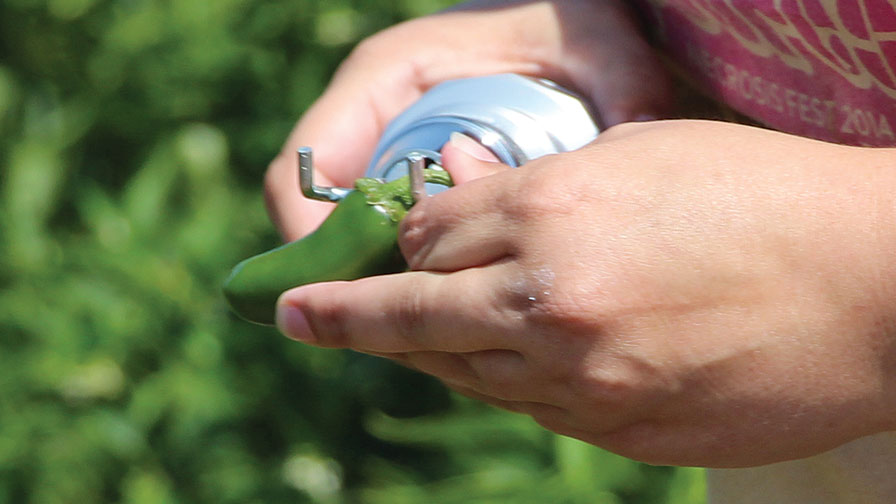Plant Breeding Is a Key Part of Precision Agriculture’s Future [Opinion]

This custom instrument at the University of California trial gardens measures the force it takes to harvest a pepper.
One theme that stood out to me while attending vegetable seed trials this past summer was how much breeders are keeping future automation in mind.
I heard about peppers that grow more upright from the plant instead of nestled inside leaves, and about longer stems that will be harvest friendly.
The University of California, Davis (UC Davis), American Seed Trade Association, and National Garden Bureau hosted a group of garden writers during my visit to California vegetable seed trials in August. As part of that tour, we visited UC Davis’ trial gardens where a graduate student demonstrated an instrument she had created.
It measured how much force it takes to pull a jalapeño off its plant. Originally, the instrument measured the force it would take if the pepper was pulled in a straight line from the plant.
Then researchers observed harvest crews and realized the more realistic movement was a simultaneous combination of rotation and pull. So the instrument was modified.
The goal of the study is to offer automation engineers basic data they’ll need to create machinery that will work. It’s a small piece of a much bigger future.
It’s exciting to see how much breeders are keeping an eye on automation.
And when you look more close at what they are aiming for, it’s even more encouraging.
Currently, the vast majority of automated harvesting is destructive harvesting. The entire plant is destroyed in the process. That means only the crop ripe at the time of harvest is usable, because there will be only one pass at harvest.
While I did hear a few breeders talk about trying to develop plants that will present their harvest all at once, more talked about making the fruit more accessible to robotic arms. That means, they’re banking on a future where repeated automated (i.e., non-destructive) harvests will be the norm.
That reality isn’t here yet. But it’s reassuring to know that not only engineers are working toward that future. Plant companies are doing their part to make their varieties ready, too.
Oh, One More Thing…
I talk to smart, experienced growers and researchers every month. Not everything makes it into an article. Here are three things I think you can use.
Taste is a key part of good vegetable breeding. And it’s definitely a perk for those who attend the trials.
Here are three varieties whose amazing flavors still linger for me:
![Plant Breeding Is a Key Part of Precision Agriculture’s Future [Opinion]](https://d3qz1qhhp9wxfa.cloudfront.net/growingproduce/wp-content/uploads/2017/11/Seeds-by-Design-Pineapple-tomatillo-1-150x150.jpg)
Seeds by Design’s ‘Pineapple’ tomatillo. The pineapple in the name indicates how sweet this tomatillo is — and it’s eaten raw!![Plant Breeding Is a Key Part of Precision Agriculture’s Future [Opinion]](https://d3qz1qhhp9wxfa.cloudfront.net/growingproduce/wp-content/uploads/2017/11/Sakata-Touchstone-Gold-beet-150x150.jpg)
Sakata’s ‘Touchstone Gold’ beet. Another surprisingly sweet flavor, this bright-yellow beet was lighter in the earthy undertones that come with most red varieties.![Plant Breeding Is a Key Part of Precision Agriculture’s Future [Opinion]](https://d3qz1qhhp9wxfa.cloudfront.net/growingproduce/wp-content/uploads/2017/11/Syngenta-Accolade-Cantaloupe-Rakesh-Kumar-150x150.jpg)
Syngenta’s ‘Accolade’ cantaloupe. Lead Melon Breeder Rakesh Kumar insisted I stay long enough to try his pride and joy. And he was right — this was a flavor worth savoring.










